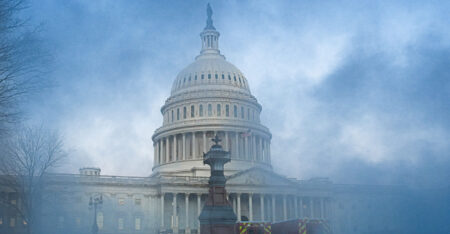Everyone wants to pay lower electricity bills, and construction companies can insulate newer residential and commercial buildings to lower heating and cooling costs while those in existing structures may choose to install upgrades to create greater energy efficiency. So, why is it then that local Washington, D.C., officials are imposing draconian building efficiency mandates on district citizens, substantially raising the costs for families and businesses?
These mandated standards, which came into effect this year, are enforced through the Building Energy Performance Standards program, which requires that building owners establish energy-use benchmarks based on recent energy use or Energy Star scores (a federal energy efficiency scoring program).
These benchmarks and the Energy Star scores are reported to the district government, which then uses them to set the efficiency requirements. These standards require each building to reduce energy use by 20% or to meet a set Energy Star score for buildings of similar types. This process is conducted over six-year cycles, the first of which is underway. Standards will become more stringent with each cycle that is concluded.
All private and district-owned buildings over 10,000 square feet are subject to the mandate, regardless of age. This means that older, less efficient buildings, including multiuse housing and schools, will be held to the same standards as newly constructed buildings, which will result in much higher costs for existing structures to come into compliance. As pointed out in a recent study on decarbonization efforts in New York, retrofitting existing structures is significantly more expensive than the upfront costs for building to the standards in new construction.
Even something as simple as replacing old windows with Energy Star-compliant ones can cost up to $2,000 per window. Another study estimates that the cost of retrofitting to achieve energy consumption reductions similar to what will likely be required by the Building Energy Performance Standards would be between $2.50 and $3.75 per square foot for residential buildings and up to $8.50 per square foot for commercial ones. Other studies show costs can be much, much higher.
According to the district’s Department of Energy and Environment, the goal of the standards is “to reduce greenhouse gas emissions and energy consumption by 50% by 2032.” The first question needs to be, to what end? According to the Sustainable DC 2.0 Plan website, the objectives are two-fold. The first objective is to address climate change. The second is to address the economic and social needs of residents.
Let’s look at climate first. According to one analysis, the standards would result in an annual “greenhouse gas” reduction of 1.05 million tons of carbon dioxide. That might seem like a lot until you compare it the 6,340.2 million metric tons emitted by the United States each year.
Still, one could argue that the district should do its part and if everyone in the country reduced their carbon dioxide emissions by half, as called for by the the district’s plan, then we could make a real difference.
But they would be wrong.
According to an analysis by The Heritage Foundation’s chief statistician, Kevin Dayaratna, eliminating all U.S. greenhouse gas emissions would reduce temperatures by less than 0.2 degrees Celsius by 2100—and that’s assuming one accepts the underlying assumptions of global warming alarmism.
In other words, despite the district’s official rhetoric, neither its building efficiency standards nor anything else in its extremist agenda would have any effect on global warming whatsoever.
But even if the standards were to reduce global warming, it is important to understand how the building efficiency standards would affect the economic and social needs of district residents.
Affordable housing is a growing problem in Washington and one that Mayor Muriel Bowser has prioritized. That’s good news given that the district has the fourth highest cost of living among America’s 100 largest cities. The bad news is that building efficiency standards will raise the cost of housing significantly.
According to a recent study that analyzes a similar mandate in Canada, the standards would increase home construction costs there by tens of thousands of dollars. Multiple studies show the same trajectory. The bottom line is that efficiency mandates increase property prices. Even the Energy Star program reports that such upgrades can result in rent increases of up to 16% and property sale prices increasing by up to 31%. Whether the district’s bureaucrats like it or not, efficiency mandates drive property prices higher, and housing costs will be sure to follow.
This is not because efficiency is bad but because mandates don’t allow property owners to choose the most cost-effective efficiency upgrades. A third-party study presented by the district’s Department of Energy and Environment shows that space heating upgrades can provide 32% of the Building Energy Performance Standards program’s projected savings while accounting for only 11% of projected costs. This would be an economically rational upgrade that doesn’t need a mandate because many people would voluntarily do it to save money. Air conditioning upgrades, on the other hand, provide only 6.5% savings at 16% of costs and would likely enjoy a much narrower market appeal.
Yet both are presented as contributing to meeting the energy standards mandate. Essentially, the most economically efficient upgrades would subsidize the more costly ones. The perverse result is that the less cost-effective options will likely never become more affordable because people will be forced to purchase them whether they make sense or not.
And if you fall under the energy standards and decide not to comply, the city could fine owners of its largest buildings up to $7.5 million dollars. In other words, the district government’s efficiency ideas are so good that they are forcing citizens to comply—and if citizens don’t comply, they will pay dearly.
Everyone wants our cars to be fuel efficient and our homes to be energy efficient. These are preferences that nearly everyone shares.
But efficiency is often not free. It’s often the case that consumers pay more up front to achieve greater efficiency savings over time. For many families and businesses, the near-term costs are worth the long-term savings. However, it’s also true that many consumers, especially those with less financial flexibility, could use those extra dollars in the near term for more vital needs like food and housing. Additionally, as stated previously, some so-called efficiencies take much longer to pay for themselves, if they ever do.
Because greater efficiency is broadly desired, manufacturers will continue to work to bring costs down so that greater efficiency becomes more generally available and they can sell more products. Over time, products of all sorts become more efficient and less expensive. The benefits are obvious, and, left alone, the system works extraordinarily well.
But that is not what the district’s program is offering. By imposing efficiency mandates, the program will drastically increase the costs for new buildings and make owning older buildings much more expensive, raising rents and mortgage payments and upgrade costs for families and businesses alike.
And make no mistake, while the current program only applies to buildings of 10,000 square feet or larger, this program will expand to eventually include all buildings and homes.
The new standards are big government paternalism at its worst. They raise costs on individual families and businesses and empower district bureaucrats and special interests. But unlike when Washington imposes such measures on all Americans, district residents can vote with their feet.
Based on Washington’s failure to entice businesses and workers back into downtown post pandemic, that seems to be exactly what is happening.
Have an opinion about this article? To sound off, please email letters@DailySignal.com, and we’ll consider publishing your edited remarks in our regular “We Hear You” feature. Remember to include the URL or headline of the article plus your name and town and/or state.
Read the full article here














